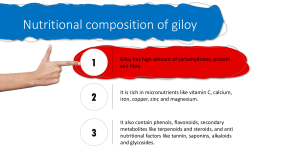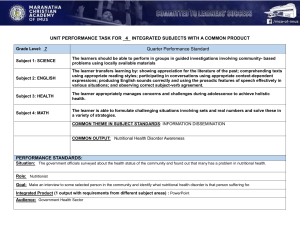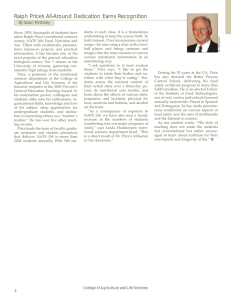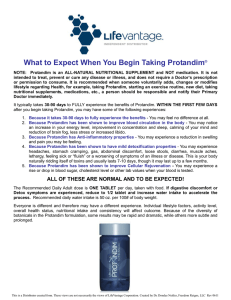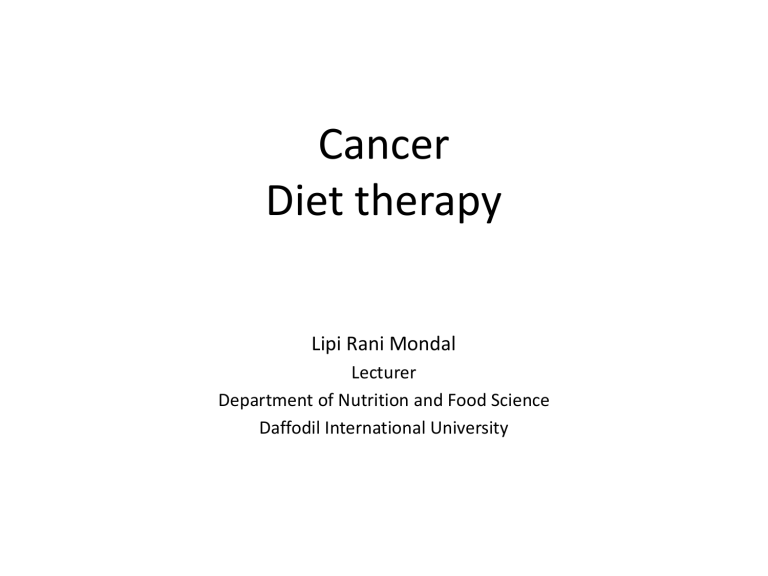
Cancer Diet therapy Lipi Rani Mondal Lecturer Department of Nutrition and Food Science Daffodil International University What is Cancer • Cancer is a group of more than 100 different diseases. Cancer occurs when cells become abnormal and keep dividing without control or order. Most cancers are named for the type of cell or organ in which they begin. Types of cancer • Adenocarcinoma: a cancer that begins in cells that line the internal organs. • Carcinoma: a cancer that begins in the skin or in tissue that lines or covers internal organs. Arises from the surface, glandular, or parenchymal epithelium. • Lymphoma: cancer appearing in the lymph nodes, spleen, liver, and bones (Hodgkin’s). Cancer screening • Screening for cancer includes physical examination, laboratory tests and procedures, and the use of imaging modalities to look at internal organs. • The most common detection and diagnostic tools are CT (or CAT) scans, MRI, ultrasonography, endoscopy, and biopsy. Common tests include blood and urine tests, Pap smears, mammograms, fecal occult blood, and others as needed. • Following the results of the screening, a determination is made of the size and extent of the cancer, and a treatment plan is developed. This process is called staging. Effect of nutritional status • The nutritional status of the individual predicts tolerance and response to therapy. Individuals who do not lose weight have significantly longer survival time than those who do. • Malnourished individuals are most susceptible to infection and less likely to tolerate or derive optimal benefits from therapy. • Malnutrition is also an important issue in the quality of life of individuals diagnosed with cancer. • Many studies indicate that more cancer patients die of malnutrition than from the disease. THE BODY’S RESPONSE TO CANCER • The specific type of cancer, and the disease process itself, has profound effects on the entire body system and cause primary nutritional deficiencies. • Cancers occurring in the gastrointestinal tract or adjacent tissue cause difficulty in ingestion and use of nutrients. • Obstruction curtails intake, and malabsorption interferes with digestion of fats and fat-soluble vitamins, especially vitamin D, which in turn leads to decreased metabolism and absorption of calcium, causing osteomalacia. • Abdominal tumors may cause fistulas to develop, leading to bypass of the small intestine and consequent malabsorption. • Adenocarcinoma of the colon leads to severe electrolyte imbalance. General malabsorption also contributes to fluid and electrolyte imbalance. Vomiting and diarrhea result in loss of water-soluble vitamins. • Pancreatic cancer and resulting pancreatectomy lead to the loss of digestive enzymes and diabetes mellitus. THE BODY’S RESPONSE TO MEDICAL THERAPY Common Nutritional Problems Occurring in Cancer Patients with Three Major Treatment Modes Nutrition Therapy in Cancer • Nutrition therapy for cancer patients is highly individ- ualized, depending on the body’s -response to the dis- ease, - the site of the cancer, -the type of treatment, and -the specific physical and -psychological responses of the pa- tient. PLANNING DIET THERAPY The objectives of diet therapy are to do the following: Nutritional needs • Increased nutritional needs based on the demands of the disease and treatment. Individual needs may vary, but the general guidelines are the same. 1. Energy:Increase total energy value to prevent excessive weight loss and meet increased metabolic demands. An adult in good nutritional status requires less than 2000 kcalories per day for maintenance. A severely malnourished patient may require 3000 to 4000 kcalories. Carbohydrates should supply most of the energy intake with fat restricted to about 30% of total calories. Harmful therapies • Many individuals with cancer or AIDS subscribe to unproven nutritional therapies, like Herbal remedies, macro- biotic diets, metabolic therapy, and thymus gland extracts from personal beliefs that it will help them take control of their disease, on the advice of family and friends, or information found on Web sites and other media. • Megavitamin and mineral therapies (taking 10 times the RDAs/DRIs) are among the most often used. Vitamins that are popular are A, C, B12, and thiamine, and the minerals iron, zinc, and selenium. These therapies and others can be harmful Special considerations in feeding a cancer patient include the following:
